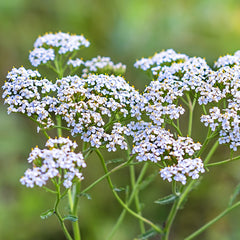Yarrow, Achillea millefollium, is a member of the sunflower family found in the wild throughout the temperate regions of the Northern Hemisphere. It had segmented leaves (millefollium means “a thousand leaves”) and clusters of daisy-like whitish flowers.
Its genus name, Achillea, comes from a Greek myth that yarrow was given to Achilles by the centaur Chiron. Achilles painted himself with a yarrow paste to make himself invulnerable to arrows, everywhere on his body except his heel. One of the world’s oldest medicinal plants, yarrow was found along with other medicinal herbs in a Neanderthal burial site in Iraq which dates from around 60,000 BC.
Yarrow has been used as a natural medicine for centuries. It has astringent, antimicrobial, and anti-inflammatory properties. Since it is natural antimicrobial properties help prevent wound infections, yarrow is often found in healing salves and ointments. A natural chemical called achilleine, present in yarrow can help stop bleeding and decrease pain.
Yarrow displays anti-inflammatory properties which makes it a great topical herb for inflammatory skin problems like eczema. Its astringent properties make it helpful for problem skin, oily skin, and large pores. A facial steam containing yarrow can be helpful for clogged pores. Yarrow has also been and as a sedative to relieve anxiety or insomnia.
Herbalists have used yarrow to help alleviate the symptoms of mastitis, a breast infection that can occur when breastfeeding. Yarrow poultices may also provide healing and pain relief from sore, cracked nipples. (Of course, always check with your health practitioner before using herbal medicine to treat any infection.)
In hair care, yarrow may help ease dandruff and itchiness, sooth scalp inflammation or irritation, rid hair of excess oil, enhance volume, and help remove build up which may lead to hair loss. Regular use of a strong yarrow tea is believed to lighten hair.



